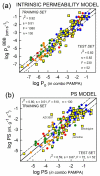P-glycoprotein deficient mouse in situ blood-brain barrier permeability and its prediction using an in combo PAMPA model
- PMID: 19591928
- PMCID: PMC2747801
- DOI: 10.1016/j.ejps.2009.06.009
P-glycoprotein deficient mouse in situ blood-brain barrier permeability and its prediction using an in combo PAMPA model
Abstract
The purpose of the study was to assess the permeability of mouse blood-brain barrier (BBB) to a diverse set of compounds in the absence of P-glycoprotein (Pgp) mediated efflux, to predict it using an in combo PAMPA model, and to explore its role in brain penetration classification (BPC). The initial brain uptake (K(in)) of 19 compounds in both wild-type and Pgp mutant [mdr1a(-/-)] CF-1 mice was determined by the in situ brain perfusion technique. PAMPA measurements were performed, and the values were used to develop an in combo model, including Abraham descriptors. Published rodent K(in) values were used to enhance the dataset and validate the model. The model predicted 92% of the variance of the training set permeability. In all, 182 K(in) values were considered in this study, spanning four log orders of magnitude and where Pgp decreased brain uptake by as much as 14-fold. The calculated permeability-surface area (PS) values along with literature reported brain tissue binding were used to group molecules in terms of their brain penetration classification. The in situ BBB permeability can be predicted by the in combo PAMPA model to a satisfactory degree, and can be used as a lower-cost, high throughput first-pass screening method for BBB passive permeability.
Figures





References
-
- Abbott NJ. In vitro models for examining and predicting brain uptake of drugs. In: Testa B, van de Waterbeemd H, editors. Comprehensive Medicinal Chemistry II, Vol. 5: ADME-Tox Approaches. Elsevier; Amsterdam: 2007. pp. 301–320.
-
- Abraham MH, Takács-Novák K, Mitchell RC. On the partition of ampholytes: application to blood-brain distribution. J. Pharm. Sci. 1997;86:310–315. - PubMed
-
- Abraham MH. The factors that influence permeation across the blood-brain barrier. Eur. J. Med. Chem. 2004;39:235–240. - PubMed
-
- Aoyagi M, Agranoff BW, Washburn LC, Smith QR. Blood-brain barrier transport of 1-aminocyclohexanecarboxylic acid, a nonmetabolic amino acid for in vivo studies of brain transport. J. Neurochem. 1988;50:1220–1226. - PubMed
-
- Avdeef A. Absorption and Drug Development. Wiley-Interscience; 2003. pp. 116–246.
Publication types
MeSH terms
Substances
Grants and funding
LinkOut - more resources
Full Text Sources
Miscellaneous

